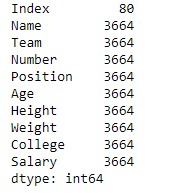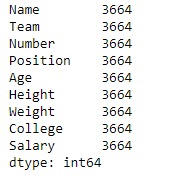Python是进行数据分析的一种出色语言,主要是因为以数据为中心的python软件包具有奇妙的生态系统。 Pandas是其中的一种,使导入和分析数据更加容易。
Pandas dataframe.memory_usage()函数以字节为单位返回每列的内存使用情况。内存使用情况可以选择包括索引和对象dtype元素的贡献。默认情况下,此值显示在DataFrame.info中。
用法: DataFrame.memory_usage(index=True, deep=False)
参数:
index:指定是否在返回的Series中包括DataFrame索引的内存使用情况。如果index = True,则索引的内存使用量将是输出中的第一项。
deep:如果为True,则通过询问对象dtype来深入了解数据的系统级内存消耗,并将其包含在返回值中。
返回:一个系列,其索引是原始列名,其值是每列的内存使用量(以字节为单位)
要链接到代码中使用的CSV文件,请单击此处
范例1:采用memory_usage()函数打印数据帧中每一列的内存使用情况以及索引的内存使用情况。
# importing pandas as pd
import pandas as pd
# Creating the dataframe
df = pd.read_csv("nba.csv")
# Print the dataframe
df
让我们使用memory_usage()函数查找每一列的内存使用情况。
# Function to find memory use of each
# column along with the index
# even if we do not set index = True,
# it will show the index usage as well by default.
df.memory_usage(index = True)输出:

范例2:采用memory_usage()函数查找每一列而不是索引的内存使用情况。
# importing pandas as pd
import pandas as pd
# Creating the dataframe
df = pd.read_csv("nba.csv")
# Function to find memory use of each
# column but not of the index
# we set index = False
df.memory_usage(index = False)输出:

相关用法
- Python pandas.map()用法及代码示例
- Python Pandas Series.str.len()用法及代码示例
- Python Pandas.factorize()用法及代码示例
- Python Pandas TimedeltaIndex.name用法及代码示例
- Python Pandas dataframe.ne()用法及代码示例
- Python Pandas Series.between()用法及代码示例
- Python Pandas DataFrame.where()用法及代码示例
- Python Pandas Series.add()用法及代码示例
- Python Pandas.pivot_table()用法及代码示例
- Python Pandas Series.mod()用法及代码示例
- Python Pandas Dataframe.at[ ]用法及代码示例
- Python Pandas Dataframe.iat[ ]用法及代码示例
- Python Pandas.pivot()用法及代码示例
- Python Pandas dataframe.mul()用法及代码示例
- Python Pandas.melt()用法及代码示例
注:本文由纯净天空筛选整理自Shubham__Ranjan大神的英文原创作品 Python | Pandas dataframe.memory_usage()。非经特殊声明,原始代码版权归原作者所有,本译文未经允许或授权,请勿转载或复制。
